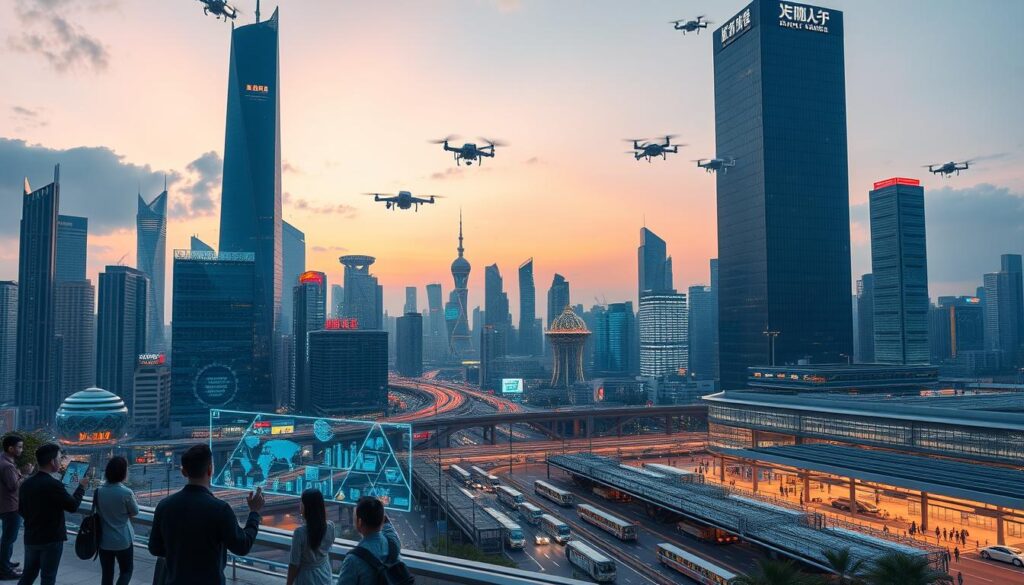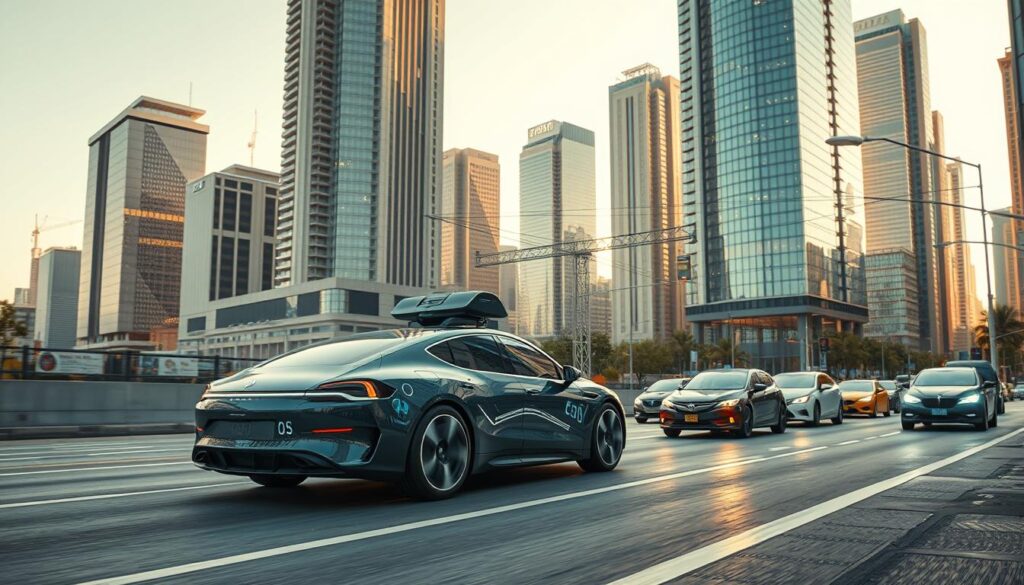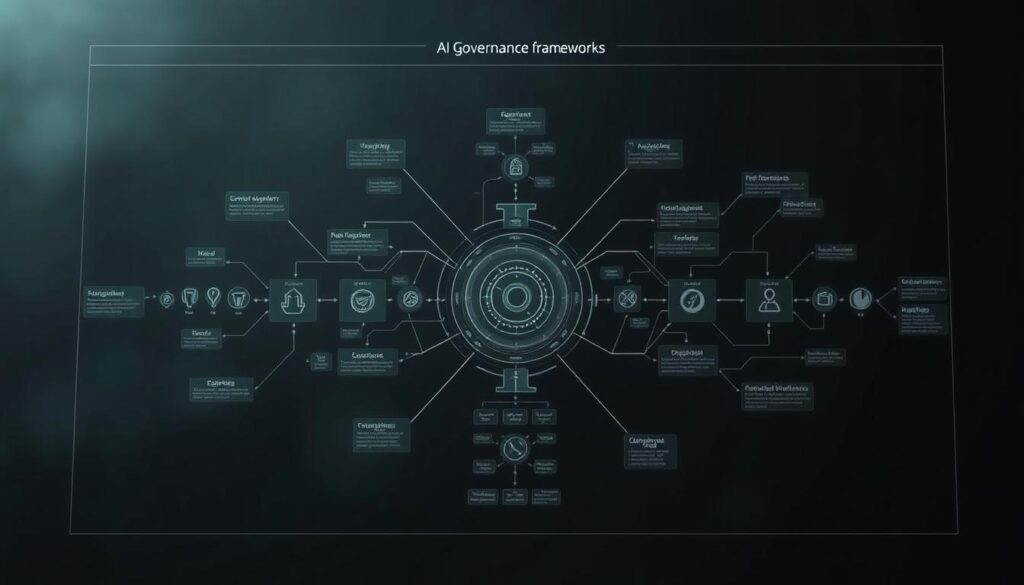“The future belongs to those who embrace innovation and adapt to change.” This quote by a well-known figure perfectly captures the essence of China’s rapid advancements in artificial intelligence. The country has positioned itself as a global leader in this transformative technology, driving strategic growth across various sectors.
Leading companies in China are leveraging cutting-edge AI to revolutionize industries. From logistics to surveillance, the integration of AI is reshaping the landscape of business and governance. This centralized, state-directed approach contrasts with the decentralized model seen in other countries, highlighting China’s unique strategy1.
China’s commitment to AI is evident in its ambitious goals and substantial investments. With over 4,500 firms developing AI technologies and a focus on STEM education, the country is fostering a robust ecosystem for innovation2. This dedication is not only transforming the domestic industry but also influencing global trends.
Key Takeaways
- China aims to lead in AI by 2030, surpassing other nations1.
- State-directed AI strategies drive innovation across industries.
- Over 4,500 firms are developing AI technologies in China2.
- AI integration is reshaping logistics, surveillance, and governance.
- Substantial investments in STEM education support AI advancements2.
Overview of China’s AI Revolution

China’s AI revolution is reshaping industries globally with groundbreaking innovations. The country’s strategic focus on artificial intelligence has positioned it as a leader in technological advancements, driving competition and fostering new models of innovation3.
Key trends in innovation and technology are pushing the boundaries of what’s possible. State-of-the-art AI models are being developed at an unprecedented pace, with over 4,300 companies contributing to this ecosystem3. From healthcare to autonomous vehicles, these advancements are transforming industries and setting new standards.
Key Trends in Innovation and Technology
China’s AI industry grew at an annual rate exceeding 10% from 2018 to 2022, reaching a core industry value of RMB 508 billion in 20223. Shenzhen has emerged as a hub for upstream AI development, with significant progress in data, computation resources, and hardware infrastructure3.
DeepSeek’s mobile chatbot, for example, surpassed OpenAI’s ChatGPT in downloads shortly after its launch, showcasing the rapid pace of innovation3. This competitive edge is further supported by substantial investments, such as the Bank of China’s plan to provide 1 trillion Yuan in funding to AI companies over the next five years3.
The Global Impact on Industry Growth
The global impact of China’s AI advancements is undeniable. Goldman Sachs forecasts that these innovations could boost corporate earnings by 2% and increase valuations by 20%3. However, challenges remain, as U.S. export controls constrain access to advanced computing resources, affecting AI training and inference4.
China’s deployment of nearly 300,000 industrial robots in 2023 highlights its leadership in automation, compared to 50,000 in Japan and 40,000 in the U.S4.. This focus on self-reliance in science and technology is driving the country’s ambition to become a global powerhouse by 20354.
As China continues to innovate, its AI revolution is not only transforming domestic industries but also influencing global trends, setting the stage for a new era of technological leadership.
Market Dynamics in China’s AI Sector

Government initiatives are playing a pivotal role in shaping the competitive dynamics of China’s AI industry. Strategic funding and policy frameworks are accelerating innovation, creating a robust ecosystem for growth5.
The competitive landscape is evolving rapidly, with over 4,500 firms actively developing advanced technologies. This surge is driven by substantial investments, particularly in areas like data infrastructure and hardware5.
Investment trends highlight the sector’s potential. Venture capital flows into AI ventures have increased significantly, with forecasts predicting continued growth. The Bank of China, for instance, plans to provide 1 trillion Yuan in funding over the next five years5.
Business expansion strategies are also reshaping the market. Companies are leveraging open-source models to bypass restrictions and tap into global talent pools. This approach has led to a rapid release of powerful AI models, challenging traditional monetization strategies6.
Competitive Landscape and Investment Trends
The AI sector in China is marked by intense competition and innovation. Major tech groups like Alibaba and Tencent are releasing advanced models at an unprecedented pace. These developments are not only transforming domestic industries but also influencing global markets6.
Government support remains a key driver. Policies aimed at fostering self-reliance in technology are propelling the industry forward. This focus is evident in the deployment of nearly 300,000 industrial robots in 2023, showcasing China’s leadership in automation6.
Looking ahead, the sector is poised for further growth. With strategic investments and a focus on innovation, China is set to maintain its competitive edge in the global AI landscape5.
how use china ai: Strategies and Applications

Strategic applications of advanced technologies are transforming industries across the globe. These innovations are reshaping traditional approaches, enabling businesses to achieve higher levels of efficiency and intelligence. By integrating systematic processes, firms are redefining their operational landscapes and gaining a competitive edge.
One key area of focus is the design and development of intelligent systems. These systems leverage advanced language models to enhance communication and decision-making. For example, startups are using large language models (LLMs) to streamline customer interactions and improve service delivery7.
In addition to design, deployment strategies are also evolving. Companies are adopting AI-driven processes to optimize workflows and reduce costs. This approach ensures higher operational intelligence, enabling firms to respond quickly to market changes8.
Real-world examples illustrate the impact of these strategies. For instance, Tencent’s AI medical imaging technology is revolutionizing healthcare delivery, while Alibaba’s AI-driven diagnostics are improving patient outcomes7. These applications highlight the transformative potential of advanced technologies.
| Application Area | Impact |
|---|---|
| Healthcare | Improved diagnostics and patient care |
| Customer Service | Enhanced communication and efficiency |
| Operations | Streamlined workflows and cost reduction |
To maximize efficiency, businesses must focus on integrating these technologies into their core operations. By adopting a strategic approach, firms can unlock new opportunities and drive innovation in their respective industries.
Advancements in Autonomous Vehicle Technologies

The race to develop autonomous vehicles is accelerating, with cutting-edge technologies leading the charge. Innovations in AI are transforming self-driving cars, making them safer and more efficient. This progress is reshaping the automotive industry and setting new standards for transportation.
Integration of AI in Self-Driving Cars
AI plays a crucial role in the development of self-driving cars. Advanced algorithms enable vehicles to process vast amounts of datum in real-time, ensuring safe navigation. These systems rely on sensors, cameras, and machine learning to make split-second decisions9.
For example, Xpeng Motors plans to launch its Level 3 autonomous driving technology in the second half of the year. This advancement allows vehicles to operate with minimal human intervention under specific conditions10.
Market Competition in the EV Sector
The EV sector is witnessing intense competition as firms strive to lead in autonomous driving. Companies like GAC Group are testing Level 3 autonomous vehicles on public roads, with plans for mass production this year9.
Over 50 cities in China have implemented pilot demonstration policies to support the commercialization of self-driving systems. This initiative is driving rapid advancements and fostering a competitive market10.
| Company | Technology Level | Launch Timeline |
|---|---|---|
| Xpeng Motors | Level 3 | Second Half of 2025 |
| GAC Group | Level 3 | 2025 |
The media has played a significant role in highlighting these advancements, bringing attention to the growing importance of AI in transportation. As the race for innovation continues, the future of autonomous vehicles looks promising, with widespread adoption expected by 20269.
AI Innovations Transforming Healthcare and Pharmaceuticals

The healthcare sector is undergoing a transformation, driven by groundbreaking advancements in technology. Artificial intelligence is at the forefront, enabling breakthroughs in diagnostics, drug discovery, and personalized therapy. These innovations are not only improving patient outcomes but also setting new standards for medical practices.
AI-Driven Drug Discovery and Diagnostics
AI is revolutionizing drug discovery by significantly reducing time and costs. For instance, the first drug discovered using generative AI entered clinical trials in 2023, developed in less than 18 months at a cost of under $3 million. This contrasts sharply with traditional methods, which take an average of six years and cost over $18 million11.
In diagnostics, AI-powered systems like CardioMind are enhancing precision. Currently in trial at Shanghai’s Zhongshan Hospital, CardioMind assists in diagnosing cardiovascular disease, a critical application given the hospital’s 820,000 outpatient visits last year11.
Emerging Solutions Like MedGPT
MedGPT is a prime example of how AI is reshaping healthcare. This advanced system generates detailed diagnostic reports, enabling personalized treatment plans. Its integration into hospitals has streamlined workflows, ensuring higher efficiency and accuracy12.
Another notable application is the HiThings Tele-ICU, which integrates real-time patient data with 3D modeling for enhanced critical care management. Such innovations highlight the transformative potential of AI in healthcare12.
- AI reduces drug discovery timelines by over 70%11.
- CardioMind improves diagnostic accuracy in cardiovascular care11.
- MedGPT generates personalized treatment plans12.
- HiThings Tele-ICU enhances critical care management12.
These advancements underscore the critical role of AI in modern healthcare. By leveraging curated content and practical applications, the industry is poised for unprecedented growth and innovation.
Scaling Power and Infrastructure for AI Demands

The rapid rise in energy consumption driven by advanced technologies is reshaping global infrastructure. As language models and data centers expand, the strain on electrical grids and energy systems is becoming increasingly evident. This growth is prompting significant upgrades to ensure stable and efficient power delivery13.
Impact on Electrical Grids and Equipment
Power demands from advanced systems are pushing electrical grids to their limits. In Europe, data centers alone are projected to account for one-third of the region’s total power consumption13. This surge is driving the need for sector-wide upgrades, with an estimated $720 billion required for grid infrastructure by 203013.
Hyperscalers, which consume 35-40% of their energy for cooling, are further intensifying the demand13. The exponential increase in connection requests to power distribution operators highlights the urgency of these upgrades13.
Upgrading Energy Systems for Higher Consumption
To meet soaring energy needs, energy systems must undergo significant transformations. Global electricity consumption is projected to rise from 25,585 TWh in 2022 to 29,160 TWh by 203014. This growth is driven by the expansion of data centers and advanced technologies like language models.
In the United States, the primary market supply for data centers increased by 26% in 2023, reaching 5.2 GW14. Such developments underscore the importance of long-term investments in energy infrastructure to ensure stable service delivery13.
| Region | Projected Power Demand Increase | Key Challenges |
|---|---|---|
| Europe | 10-15% over 10-15 years | Grid infrastructure upgrades |
| United States | 26% increase in data center supply | Cooling and energy efficiency |
| Global | 29,160 TWh by 2030 | Long-term investment needs |
These trends highlight the critical role of information and strategic planning in addressing the challenges posed by rising energy demands. For more insights on integrating advanced technologies into business strategies, visit AI in Business.
Navigating Government Policies and AI Governance Frameworks

The evolving regulatory landscape is shaping the future of advanced technologies globally. In 2023, China became the first country to implement detailed, binding regulations on common applications of AI, setting a precedent for other nations15. These measures reflect a dual strategy of maintaining control over emerging risks while fostering development and innovation15.
Regulations on Algorithm Management
China’s regulatory framework includes the Algorithmic Recommendations Provisions and Deep Synthesis Regulations, introduced in 2021 and 2022, respectively15. These policies aim to ensure transparency and accountability in algorithm usage. For instance, the Measures for the Management of Generative Artificial Intelligence Services, issued in July 2023, require service providers to adhere to strict technical standards15.
Experts highlight that these regulations emphasize a “people-centered approach,” focusing on ethical considerations and societal impact16. The National Technical Committee 260 on Cybersecurity has also issued guidelines to ensure compliance with privacy and data protection laws16.
Implications for Technology and Media
The strict control over algorithms has significant implications for the technology and media sectors. Companies must ensure their systems meet prescribed thresholds before market entry, particularly in high-risk fields16. This approach has led to increased scrutiny of training data and outputs to prevent misuse16.
Globally, these policies are influencing standards in the world of AI governance. For example, the EU’s AI Act categorizes high-impact models with stricter obligations, mirroring China’s regulatory approach15.
| Regulation | Key Focus | Effective Date |
|---|---|---|
| Measures for Generative AI Services | Technical standards and compliance | August 15, 2023 |
| Algorithmic Recommendations Provisions | Transparency and accountability | 2021 |
| Deep Synthesis Regulations | Ethical considerations | 2022 |
These frameworks underscore the interconnected nature of governance, policy, and technological innovation. By involving multiple stakeholders, including expert advisory committees, China is setting a benchmark for AI regulation15.
Securing Investment and Funding in China’s AI Landscape

Securing funding has become a cornerstone for driving innovation in the rapidly evolving technological landscape. In China, state-backed financial support plays a pivotal role in nurturing advancements, ensuring the country remains a global leader in artificial intelligence17.
The Chinese government has set an ambitious goal to build a 1 trillion yuan AI-powered economy by 2030, as outlined in the 2017 Artificial Intelligence Development Plan17. This vision is supported by substantial investments, including the Bank of China’s pledge of 1 trillion yuan over the next five years to strengthen the AI supply chain17.
State-Backed Financial Support and VC Trends
State-directed funding is a key driver of innovation. Over 2,100 government guidance funds, targeting a total size of $1.86 trillion, have been established to support strategic sectors like AI17. These funds provide critical resources for startups and established firms alike.
Venture capital trends also highlight the sector’s growth. Companies developing large language models (LLMs) have attracted significant attention, with over 50 firms actively working on these technologies18. This focus on LLMs reflects a broader strategy to lead in cutting-edge AI applications.
Local governments are further supporting innovation through initiatives like computing vouchers, offering up to $300,000 per company to offset rising costs17. Such measures ensure that even smaller startups can compete in this dynamic market.
Strategic Investment Moves by Global Players
Global financial institutions are also recognizing the potential of China’s AI sector. For example, J.P. Morgan Research highlights the increasing involvement of international investors in funding AI ventures17. This collaboration underscores the global significance of China’s technological advancements.
To maximize their impact, companies are adopting innovative funding strategies. Partnerships between businesses and governments, such as the Urban Brain 2.0 initiative, are driving large-scale projects that align with national goals17.
As the AI landscape continues to evolve, securing adequate funding remains essential for achieving long-term success. For more insights on leveraging technology for business growth, explore AI-driven strategies.
Company Case Studies: Leading AI Start-Ups in China

Emerging start-ups in the tech sector are redefining innovation with groundbreaking advancements. Among these, Zhipu AI and Moonshot AI stand out as pioneers, driving transformative changes in the industry. Their success stories offer valuable insights into the strategies and challenges of scaling in a competitive market.
Zhipu AI: A Trailblazer in Language Models
Zhipu AI has made significant strides with its GLM-4 model, which scored 76 on the SuperCLUE benchmark19. This product showcases the company’s ability to compete with global giants like OpenAI. Founded in 2019, Zhipu AI has secured backing from major players like Alibaba and Tencent, enabling rapid growth20.
One key concern for Zhipu AI has been navigating export controls on advanced microchips. Despite these challenges, the company has managed to stockpile essential hardware, ensuring uninterrupted development21.
Moonshot AI: Innovating with Kimi Chatbot
Moonshot AI’s Kimi chatbot, launched in 2022, is powered by its proprietary large language model20. This product has gained traction for its ability to handle complex queries, positioning the company as a strong competitor in the AI space. Moonshot AI’s focus on multilingual capabilities has further expanded its market reach20.
The company’s success is attributed to its strategic investments in research and development. By leveraging open-source models, Moonshot AI has minimized costs while maximizing innovation20.
Overcoming Challenges and Securing Leadership
Both Zhipu AI and Moonshot AI have faced significant hurdles, from regulatory concerns to intense competition. However, their ability to adapt and innovate has set them apart. For instance, Zhipu AI’s government-approved models demonstrate compliance with stringent standards20.
These start-ups have also benefited from state-backed funding, which has provided critical resources for scaling their operations19. This support has enabled them to use cutting-edge technologies and maintain a competitive edge.
Comparative Advantages in the Tech Industry
When compared to global counterparts, Zhipu AI and Moonshot AI showcase unique strengths. Their focus on localized solutions and multilingual capabilities has allowed them to address specific market needs20. Additionally, their ability to navigate regulatory landscapes has positioned them as leaders in the AI space.
These start-ups are not only transforming the domestic industry but also influencing global trends. Their innovative products and strategic approaches serve as a blueprint for success in the tech sector19.
Research Breakthroughs: Patents, Talent, and R&D in AI

Breakthroughs in research are driving the next wave of innovation in artificial intelligence. These advancements are not only shaping the future of technology but also solidifying China’s position as a global leader in AI development. With a focus on patents, academic contributions, and intellectual capital, the country is setting new benchmarks for innovation.
Advances in AI Research and Intellectual Capital
China’s commitment to AI research is evident in its impressive patent statistics. As of 2022, the country filed the highest number of AI patents globally22. This achievement reflects the nation’s dedication to advancing technology and securing intellectual property rights. The New Generation Artificial Intelligence Development Plan (NGAIDP) predicts that by 2030, China will achieve world-leading levels in AI theories, technologies, and applications22.
Academic institutions play a crucial role in this progress. The Action Plan emphasizes building a high-end talent team, with colleges and universities expected to become the main force behind the development of a new generation AI talent pool by 203022. Initiatives like the “Thousand Talents” plan are attracting world-class researchers, further enhancing the country’s intellectual capital22.
Scaling R&D Efforts Over Time
Over the years, China has significantly scaled its R&D efforts. The compound annual growth rate (CAGR) for the country’s annual data volume is 26%, highlighting the rapid expansion of research activities23. This growth is supported by substantial investments in infrastructure and technology, ensuring that R&D efforts remain at the forefront of innovation.
By 2025, China aims to achieve major breakthroughs in basic AI theories, with some technologies and applications reaching a world-leading level22. This ambitious goal underscores the country’s focus on continuous improvement and long-term development.
Pioneering Breakthroughs in AI Development
China’s AI industry is valued at over $70 billion as of 2025, with related sectors projected to reach a total value of $1.4 trillion by 203023. This growth is driven by over 4,300 companies contributing to advancements in the field23. The share of AI-influenced revenues in Chinese companies has increased from 12% in 2018 to a projected 36% by 2024, showcasing the sector’s expanding impact23.
One notable example is the development of large language models, which have revolutionized natural language processing. These models are being integrated into various applications, from customer service to healthcare, demonstrating their versatility and potential23.
For more insights on leveraging AI tools for research, explore AI tools for research.
Global Competitiveness: U.S. vs. China in AI Development

The global race for AI dominance is intensifying, with the U.S. and China leading the charge. Both nations are leveraging their unique strengths to shape the future of artificial intelligence. While the U.S. focuses on innovation and open collaboration, China emphasizes state-driven strategies and rapid deployment24.
Comparative Analysis of Market Strategies
The U.S. and China differ significantly in their approaches to AI development. The U.S. prioritizes private-sector innovation, with companies like OpenAI and Anthropic leading the way. In contrast, China’s state-backed initiatives, such as the $1.4 trillion investment in AI by 2030, highlight its centralized strategy25.
Technological security is another key area of divergence. The U.S. has implemented export controls to limit China’s access to advanced AI technologies, including high-end chips and cloud computing24. Meanwhile, China is investing heavily in domestic R&D to reduce reliance on foreign tech25.
Research collaboration between the two nations remains strong, with over 47,715 co-authored AI research articles. However, this collaboration is declining due to geopolitical tensions24. Despite this, joint research continues to outperform collaborations with other countries, showcasing the complementary strengths of both nations24.
Strategic Policy Interventions
Policy frameworks also differ. The U.S. introduced the Framework for Artificial Intelligence Diffusion in 2025, focusing on ethical AI development24. China, on the other hand, has implemented detailed regulations on AI applications, ensuring compliance with national security standards24.
In the tech sector, companies like Baidu and Tencent are pushing boundaries with advanced models like Ernie 4.5 and Hunyuan 3D-2.024. Meanwhile, U.S. firms like Apple are partnering with Chinese companies to develop cutting-edge AI features, highlighting potential synergies24.
| Area | U.S. Strategy | China Strategy |
|---|---|---|
| Innovation | Private-sector driven | State-backed initiatives |
| Security | Export controls | Domestic R&D focus |
| Collaboration | Declining due to tensions | Strong but selective |
| Investment | Venture capital | $1.4 trillion by 2030 |
For more insights on how AI is transforming financial strategies, explore AI-driven financial strategies.
Implications of Regulatory Changes on AI Applications
Recent regulatory changes are reshaping the landscape of AI application development, with significant implications for both domestic and global markets. These changes require firms to adapt their strategies to meet new compliance standards, ensuring long-term competitiveness26.
One key requirement is the lawful use of data, including obtaining consent for personal information. Generative AI service providers must also ensure secure and stable services, promptly addressing illegal content26. These measures aim to uphold socialist core values and prevent the generation of prohibited content26.
The cost of compliance is a major consideration for firms. Penalties for violations of the PIPL can reach up to 50 million RMB or 5% of annual revenue, while violations of the Criminal Law can result in prison sentences of up to seven years26. These financial and legal risks highlight the importance of proactive planning.
Globally, China’s regulatory framework is influencing other nations. The EU’s AI Act, for example, mirrors China’s approach by categorizing high-impact models with stricter obligations27. This alignment underscores China’s role as a global leader in AI governance.
| Regulation | Key Requirement | Effective Date |
|---|---|---|
| Interim AI Measures | Lawful data use, secure services | August 15, 2023 |
| Deep Synthesis Provisions | Ethical considerations | January 10, 2023 |
| Recommendation Algorithms | Transparency and accountability | March 1, 2022 |
To navigate these changes, firms must establish cross-functional steering committees that include legal, compliance, HR, and IT teams. Regular risk assessments are essential for identifying vulnerabilities in AI systems27. For more insights on China’s AI market, visit China’s AI market.
By embracing these regulatory shifts, companies can not only ensure compliance but also position themselves as innovators in the evolving AI landscape. Proactive planning and strategic investments will be key to maintaining a competitive edge26.
Future Trends: AI Innovations and Global Impact
The future of artificial intelligence is set to redefine industries globally, with groundbreaking innovations leading the way. As technology evolves, chatbots and large language models are expected to become even more sophisticated, transforming how businesses interact with customers28.
One of the key challenges ahead is the integration of these technologies into global supply chains. With the rise of AI-driven automation, companies must adapt to new operational models to remain competitive29. This shift will require significant investments in infrastructure and workforce training.
Anticipated Developments in AI Technology
Advancements in chatbot capabilities are expected to enhance customer service across industries. For instance, Baidu’s ERNIE Bot, which holds an 11.5% market share, is already setting new standards for generative AI applications28. Similarly, Huawei Cloud’s Ascend service has reduced large model training time from five months to just one month, showcasing the potential for efficiency gains28.
However, these innovations come with their own set of challenges. The energy consumption of data centers, projected to account for nearly 6% of China’s total electricity demand by 2026, highlights the need for sustainable solutions29. Balancing technological growth with environmental impact will be crucial.
Global supply chains are also set to undergo significant changes. AI-driven logistics systems can optimize operations, but they require robust infrastructure and regulatory support18. Companies must navigate these complexities to leverage AI’s full potential.
Regulatory and Strategic Shifts
Regulatory frameworks are evolving to address the rapid pace of AI development. China’s “Interim Measures for the Management of Generative Artificial Intelligence Services” provides a blueprint for ethical AI governance28. Similar regulations are being adopted globally, influencing how businesses deploy AI technologies.
Strategic investments will play a critical role in shaping the future of AI. With private investment in generative AI in China growing from $650 million in 2023 to $3.15 billion in 2024, the sector is poised for continued expansion28. Companies that adapt to these trends will gain a competitive edge.
As the AI landscape evolves, collaboration between governments, businesses, and researchers will be essential. By addressing challenges and embracing innovation, the global community can unlock the full potential of artificial intelligence.
Conclusion
The transformative potential of advanced technologies is reshaping global markets, with significant implications for industries worldwide. Strategic insights from this article highlight the importance of continual research and innovation in driving future growth. Government policies, investment trends, and technological breakthroughs are combining to create a robust ecosystem for progress30.
Key takeaways for business leaders and policymakers include the need to adapt to evolving regulatory frameworks and leverage technological advancements. The united states and other nations must collaborate to address challenges and ensure sustainable development in this rapidly changing landscape31.
Ongoing monitoring of trends is essential as global competition intensifies. By fostering collaboration and investing in research, stakeholders can unlock the full potential of these technologies. For more insights on emerging tools, explore AI tools revolutionizing industries.
FAQ
What are the key trends in China’s AI innovation?
How does China’s AI sector impact global industries?
What role does government policy play in China’s AI development?
How is AI transforming healthcare in China?
What are the challenges in scaling AI infrastructure in China?
How does China’s AI investment landscape compare to the U.S.?
What are the future trends in AI technology?
Source Links
- China leans into using AI − even as the US leads in developing it
- From chatbots to intelligent toys: How AI is booming in China
- China’s AI Revolution: The Global Tech Power Shift – The Geopolitics
- Assessing China’s AI development and forecasting its future tech priorities
- China’s AI Advancements: Market Implications and Investment Considerations
- Commentary: Why China is suddenly flooding the market with powerful AI models
- China’s AI Policy & Development: What You Need to Know
- Strategic Reorientation on AI Competition with China
- China advances AI-driven autonomous vehicles – The Daily CPEC
- AI expected to accelerate China’s self-driving tech
- The Future of Healthcare: How China’s medical industry is adopting AI – CKGSB Knowledge
- China Medical University and Healthcare System Pioneers AI-Driven Drug Discovery and Allogeneic CAR-T Therapy: A Groundbreaking Leap in Cancer Treatment
- AI to drive 165% increase in data center power demand by 2030
- As generative AI asks for more power, data centers seek more reliable, cleaner energy solutions
- Navigating China’s regulatory approach to generative artificial intelligence and large language models | Cambridge Forum on AI: Law and Governance | Cambridge Core
- China-releases-AI-safety-governance-framework | DLA Piper
- Beyond DeepSeek: How China’s AI Ecosystem Fuels Breakthroughs
- China’s Generative AI Ecosystem in 2024: Rising Investment and Expectations
- How Innovative Is China in AI?
- 9 of China’s top AI models and startups
- DeepSeek: Did a little-known Chinese startup cause a ‘Sputnik moment’ for AI?
- Explore Pacific Forum’s Insightful Indo-Pacific Analysis
- The AI Superpower Rivalry: A Zero-sum Game Between China and the United States?
- The American Playbook to Win the AI Race With China – American Edge Project
- AI Watch: Global regulatory tracker – China | White & Case LLP
- The Evolving AI Regulatory Landscape in Asia: What Compliance Leaders Need to Know
- China And AI In 2025: What Global Executives Must Know To Stay Ahead
- China’s AI future in a quest for geopolitical, computing and electric power
- China Closing AI-Innovation Gap with the US
- In Developing AI, China Takes the Industrial Route







